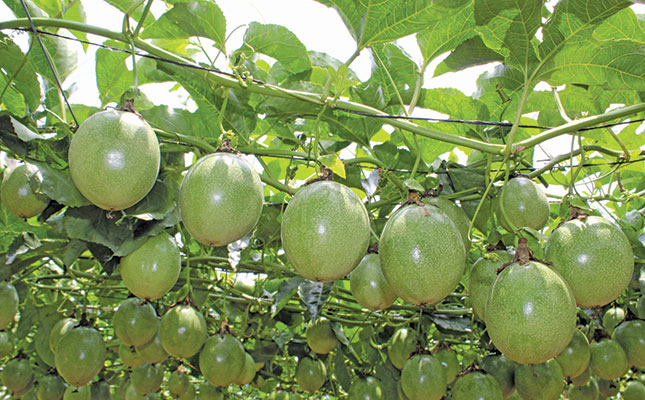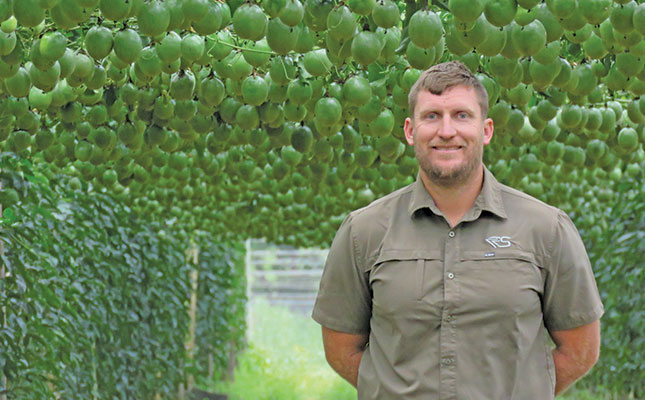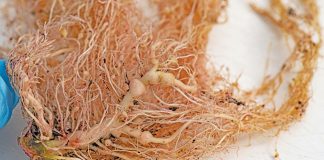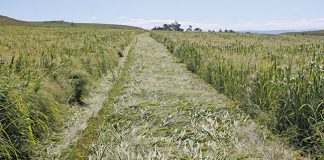
Photo: Lindi Botha
There can be few fruit cultivars whose origins are as unusual as that of the new passion fruit variety, Silesia.
When drought struck North West in the mid-2010s, game breeder Darryn Stoltz, who farmed in the province, began to look for a nutritious source of food for his herds. He was advised to plant passion fruit, as the sweet pulp was said to satisfy the animals.
Unhappy with the low yield and pulp content of the two commercially planted varieties, Ester and Edulis, Stoltz began breeding for a new, juicier variety of passion fruit, using his knowledge of crossbreeding. In 2017, after two years of trial and error, he ended up producing Silesia, a cultivar that was nearly double the size of the conventional passion fruit, sweeter and faster-growing.
While Stoltz was pleased with the result, his game were less than impressed, leaving him with a harvest and no takers. Rather than waste the produce, he set off for the market with the fruit in an effort to interest buyers. He was in luck: a buyer from Switzerland immediately showed interest, and Stoltz realised the potential of the cultivar.
He initiated a rapid expansion project, which began with registering plant breeder’s rights on the new cultivar and purchasing land near White River in Mpumalanga on which to produce the cultivar commercially. He later bought land in Limpopo as well.
Stoltz also entered into partnership with Charles Rossouw, owner of Roslé Boerdery near Groblersdal in Mpumalanga, to form Roslesia, and production was ramped up. Today, the business produces more passion fruit than that grown by the rest of South Africa’s farmers combined. Eight varieties are bred under the Silesia name, ranging in size, colour and application, from fresh produce to fruit for juicing and pulping.

Roslesia began exporting fruit in 2018, and Asia, Europe and the Middle East have become established markets for the cultivar.
Painstaking breeding
Stoltz recalls the long and arduous journey that is well known by breeders everywhere. “The plant material needs to be crossbred, grown out, tested and then multiplied to ensure you get the same results over and over from a plant. It has now been six years and I’m still making tweaks here and there, but overall I’m very satisfied with what we have.”
Stoltz specifically looked at traits that increased fruit size, flavour and resistance to pests. Breeding for disease-resistance was also a key consideration, as most of the commercially planted varieties are highly prone to disease.
He and his team managed to achieve a 60:40 ratio of pulp to peel (a ratio reversed in other cultivars), as well as a considerably sweeter fruit.
“We get a Brix value ranging between 16 and 22, which is substantially more than the Brix of the Ester and Edulis cultivars.
“[Conventional] varieties don’t provide a good eating experience. They’re sour, and the amount of pulp is minimal. I was shocked at the high prices and quality of passion fruit in supermarkets in Europe, so I knew that having a superior product would mean fitting into a market where there was already demand at high prices,” he says.
One of the greatest advantages of the Silesia cultivar is its extended shelf life; this enables it to be sent by sea, which reduces export costs.
“Conventional varieties need to be flown to their destinations, because the fruit doesn’t
hold up for the period it takes to ship,” says Stoltz.
“The Silesia can be shipped, and 30 days after arriving, it’s still in prime condition. When we first started shipping, I included a few other commercial cultivars with the shipment to test and compare the shelf life, and found that two days after arrival, the commercial fruit started decaying.
“When flights came to a halt during the COVID-19 lockdowns, I was the only passion fruit producer supplying fruit out of the Southern Hemisphere because it was sent by ship. Demand skyrocketed and has stayed there.”
Vigorous growers
Developing a new cultivar that is such a departure from those currently grown has meant having to rewrite the production manual.
“There’s not much we can use from current production methods for the Silesia, because they’re such vigorous growers. They need a lot more nutrition and attention,” says Stoltz.
Whereas the Ester passion fruit, for example, can grow up to 30cm a week, the Silesia exceeds 70cm.
“The Silesia comes into production at three months, as opposed to nine months for the Ester.”
These fast-growing plants require more water to develop their luscious flesh, but the Roslesia team has fine-tuned production to ensure that every input is used optimally.
“We use weed nets to maintain soil moisture, and the shade netting that we erect mainly for protection against hail also helps to reduce evaporation. We’ve installed low-flow drip irrigation to make sure the plants receive [sufficient] water without anything going to waste,” says Stoltz.
The cultivar’s water requirements under this system are between 12ℓ and 15ℓ/plant/week.
The Silesia cultivar produces constant, aggressive vegetative growth as well as fruit of varying size at all times, as the cultivar is a continuous producer. This makes managing its nutritional requirements trickier. Production methods have therefore been standardised across all farms in the different regions. These are constantly re-evaluated, however, to fine-tune the process and produce a new production manual.
Stoltz explains that the key to this process is balancing vegetative growth with fruit
production. “We partnered with Agri Technovation and Laeveld Agrochem to find the ideal fertiliser and crop protection regime. Leaf and soil analysis is done every two weeks and we adjust our water, fertiliser and disease management weekly to provide the optimal package for the plants.”
He adds that they continue to conduct research on production of the Silesia cultivar. “We’re in the process of building up data with the help of MyFarmWeb, and this will dictate how the crop is managed every month of the year, and at different points in its physiological cycle.
“Because the cultivar is planted in different climatic regions, from Groblersdal, which is warm and dry, to subtropical White River, management needs to adapt to ensure that the plants thrive equally well. The cultivar can grow anywhere, but proper management will determine its success.”
One of the main challenges facing the passion fruit industry, says Stoltz, is the limited number of registered crop protection products. Because the industry has been relatively small in South Africa, little research and development have been conducted to find and register new products. As a result, diseases tend to build up resistance against existing agents relatively quickly.
This, coupled with the high labour requirement, has seen many farmers exit the industry.
“Overall, passion fruit is not an easy crop to farm, so there’s not a lot of competition on the market as it is, even if the smaller fruit could compete with the Silesia. But because our fruit is so sought-after, we get an even higher premium, which can justify our six-people-per-hectare labour requirement.”
The right volumes
Silesia passion fruit has proven so popular that the crop due to be harvested in October this year has already been bought. Stoltz says that because the fruit fits into specific supermarket programmes, which are fixed before the start of a season, he isn’t concerned about fluctuating prices or produce that may have to be dumped because it doesn’t have a market.
“Our fruit is exported by Core, which handles all the marketing. We can’t keep up with demand and have to turn people away at this stage.
“We sent out samples of our fruit far and wide when we started, and the fruit spoke for itself, so we haven’t had to do much marketing. Now that supermarkets have access to larger, juicier fruit with a longer shelf life, this has become their preference.”
Scaling up production has been necessary to maintain market share. “If we were unable to supply a constant flow of fruit, we’d be building demand and then allowing it to fizzle out as production fluctuates. We need to maintain our shelf space to maintain demand.”
This is where Stoltz’s partnership with Rousouw (which came about after an introduction by Stoltz’s banker) has played a vital role. Rossouw, who specialises in export citrus, has decades of experience in cultivating high-value fruit for the export market, and a partnership made perfect sense for both parties.
The business then purchased additional farms and a packhouse, boosting production to where it is today. Production will soon be expanded to Hoedspruit as well, to capitalise on the warmer climate there.
Adding locations to spread the risk
Production takes place 10 months of the year, although the cooler temperatures in winter reduce yield. Frost can also be a problem occasionally in White River.
“This is one of the reasons we’ve spread production across regions, and across
different farms within the same region. Shade netting has also been erected on all of the farms to maintain even temperatures and guard against hail.”
Hein de Jager, general manager of Roslesia, says that guarding against climatic risks is vital in building a sustainable business.
“If a supermarket in the UK, for example, has planned a campaign based on passion fruit, we can’t [fail to deliver] on time and blame it on hail. This must be taken into account when building a business based on a niche product: consistency of supply and quality is crucial.”
Part of that consistency, as well as an important financial consideration, has been to register the Silesia cultivar. Roslesia has retained the sole licence to plant the cultivar, which opens up further opportunities. Cultivar branding and product development are the next steps for the remarkable Silesia cultivar.
Email Darryn Stoltz at [email protected], or Hein de Jager at [email protected].










